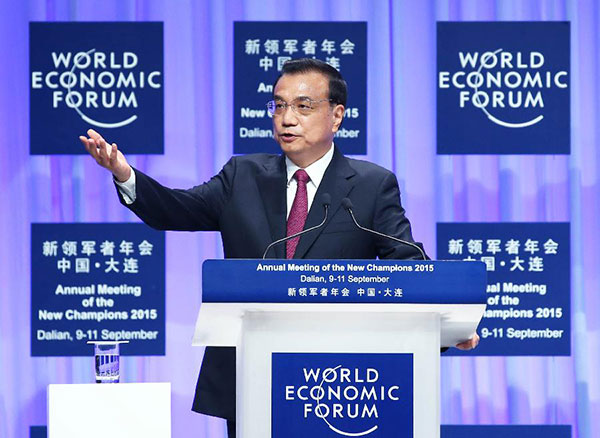A new blueprint for global growth
(China Daily) Updated: 2015-09-12 08:27
 |
|
Premier Li Keqiang makes a speech at the opening ceremony of the Annual Meeting of the New Champions 2015 in Dalian, Liaoning province, on Sept 10. [Photo/Xinhua] |
Special address by Li Keqiang, premier of the State Council of the People's Republic of China, at the ninth Annual Meeting of the New Champions, Dalian, Sept 10, 2015
It gives me great pleasure to join you in the beautiful city of Dalian in this golden autumn season of September. On behalf of the Chinese government, let me extend warm congratulations on the opening of the Annual Meeting of the New Champions. I want to welcome all guests who have traveled from afar to Dalian and I also express my sincere thanks to friends from the media.
Yesterday, I visited a local manufacturer in Dalian after I arrived. The company, which employs only 10 people, has built an impressive business in just two years' time. It has attracted 280,000 registered users through the Internet, and developed nearly 100 manufactured products. One thing it does is to develop new models for the utilization of machine tools. It has collected data on some 30,000 machine tools in northeast China, and managed to link the production of machine tools with consumers on the demand side.
Their service greatly improved the utilization rate of these machine tools. More importantly, building on the wisdom of its 280,000 registered users, it has offered smart solutions for upgrading machine tools. The company has an ambitious plan - to not just upgrade the old machine tools, but also build new and smarter ones by pooling wisdom via a public platform.
In fact, one could find tens of thousands of small companies like this in China, whose creativity is beyond our imagination. Whether they succeed in the end, they are all like the new champions. Through them, people see the future of our economy, and I believe they are all part of the new blueprint for growth in China and beyond.
At the moment, global economic recovery is still weak. Many international institutions have downgraded their global economic forecast. The more complex and intricate the situation, the more we need confidence and hope. In this context, the theme of the meeting - Charting a New Course for Growth - reflects our collective wisdom and consensus, and points the way for the future. It is therefore highly relevant.
I hope the story I shared with you could somehow help answer your question about the status and direction of the Chinese economy and the future of the world. My message is this: Despite the moderation in speed, the performance of the Chinese economy is stable and moving in a positive direction. Although difficulties remain, there are more opportunities than challenges. People's creativity and entrepreneurial passion has given us confidence to overcome the challenges. We are capable of meeting the main goals and tasks set for economic and social development this year, and this will lay a solid foundation for sustainable growth in the years to come.
Given the slowdown in global growth, the 7 percent growth China achieved in the first half of the year is not at all easy. Because we are talking about a $10 trillion economy, 7 percent growth actually generates more increase in volume than the double-digit growth in the past. And the 7 percent growth is in fact among the highest of the world's major economies.
What is more encouraging is that China's economic structure is rapidly improving. Today, the services sector already accounts for half of China's GDP, and consumption contributes 60 percent to growth. Growth in high-tech industries is notably higher than the entire industrial sector. Consumer demands for information, cultural, health and tourism products are booming. Energy conservation, environmental protection and the green economy are thriving. New economic growth areas are rapidly taking shape.
China's steady economic development has benefited the people. For us to measure the state of the economy, it's always important to know how the people are feeling. Since the beginning of this year, employment has steadily expanded. In the first six months, 7.18 million new urban jobs were created, meaning 72 percent of our annual target is already met. The surveyed unemployment rate in big cities was around 5.1 percent.
In terms of household income, per capita disposal income grew faster than the economy, with the income of rural residents growing faster than that of urban residents. As a result, consumers now have more money in their pockets to spend. Price levels have been kept basically stable. Total retail sales increased by more than 10 percent. I have said on many occasions that as long as there is sufficient employment, and if household income could increase in step with the economy and if the environment keeps improving, then a slight change in GDP growth is acceptable.
China's steady economic development has benefited the world. China contributed about 30 percent to global growth in the first half of the year. With commodity prices dropping markedly on the global market, the growth of China's foreign trade volume is slowing down. But even so, the actual amount of commodities China imported has continued to go up.
China will adopt a more proactive import policy and place greater emphasis on the quality of imports and exports. And China will only buy more from the world to meet its growing domestic demands. China's outward investment has maintained rapid growth. The number of outbound tourists has notably increased. Last year alone, Chinese tourists made over 100 million trips overseas. In the first half of this year, the number rose by another 10 percent. When Chinese tourists go abroad, they not just go sightseeing but also shopping. This shows that the Chinese people are bullish about the economic prospects. Given the celebrated tradition of frugality in China, people would hardly feel free to spend if they don't have a stable source of income.
Of course, one should not forget that more than 70 million people in China are still living in poverty. Yet, the sheer size of the middle-income population also means huge and fast-growing consumer demands. All these serve to prove that China is not a source of risks for the world economy but a real source of strength for world economic growth.
Despite the many difficulties and downward pressure, the Chinese economy is still within the reasonable range. The Chinese economy is deeply integrated into the global market. Given the weak growth of the global economy, China could not stand unaffected. Meanwhile, the deep-seated problems that have built up over the years are thrown into sharper relief.
- Chinese economy shows 'strong fundamentals', says ex-Australia PM
- A new blueprint for global growth
- Structural reforms keep Chinese economy afloat
- CIRC gives nod to insurance firms' private equity funds
- Audi's new S7 Sportback and A7 family
- Walvax adopts Medidata clinical cloud platform
- A new blueprint for global growth
- Details of US Precision Medicine Initiative to be released
















